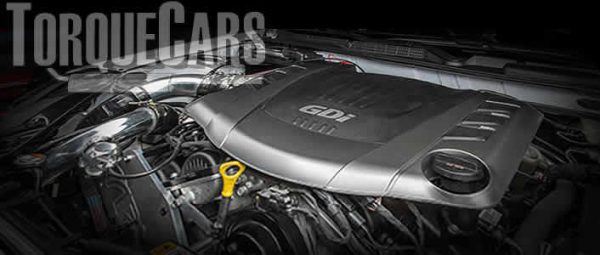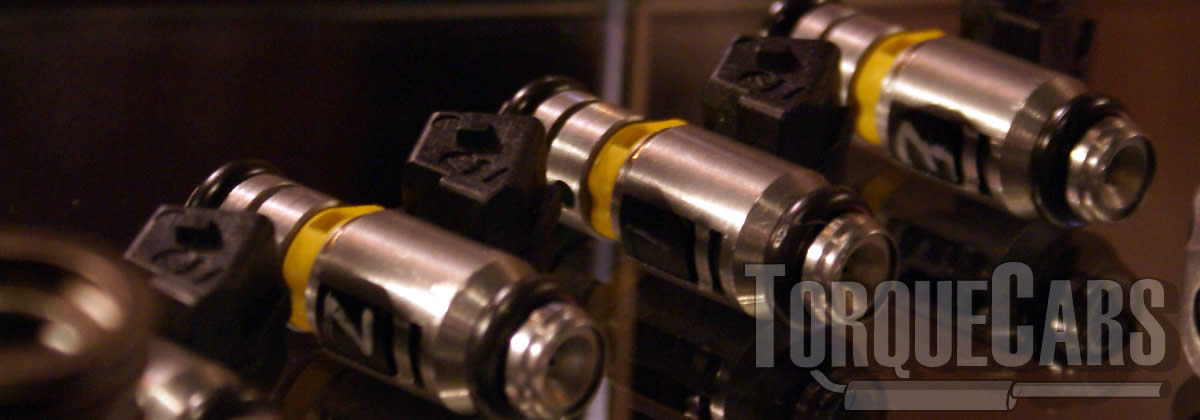Tuning the Hyundai/Mitubishi Omega / 8A8 / G8AA
"All you need to know about tuning and performance parts on the Hyundai Omega engine!"
Carref prides itself on providing the latest tips and guides to your modification project.
We detail the best approach to Omega tuning and outline the optimum modifications. Hyundai Omega great bases for a tuning project and with carefully chosen upgrades like a remap, turbo upgrades and camshafts you will positively enhance your driving enjoyment.
We rely on our visitors to pass on tips and tell us about their projects and what worked on their car, and this article is the culmination of the feedback we have received. First let us look at the history and specs of this engine and then consider which tuning modifications work best on it.
History of the Engine
The Hyundai Omega engine or G8AA (aka the 4.5D or Mitsubishi 8A8)

The engine block was cast by Hyundai and the head was produced by Mitsubishi. We love to see collaboration between car makers and have seen some impressive engines born from these partnerships.
- 4498cc has a 10.7:1 compression ratio
- DOHC with multiport fuel injection
- Power output is 256 hp 260 PS @5,500 rpm 275 lbft @2,500 rpm
This engine was replaced with the Tau engine in 2008
What are the most effective Omega parts
The top tuning mods on an engine are in our opinion the ones that give the best power gain for you spend.
We won't be swayed by popular Omega tuning mods, they need to be cost effective.
Altering your Omega cam will make a dramatic difference to the engine torque. Choosing a higher performance cam profile raises the torque accordingly.

Fast road camshafts normally bump the bhp throughout the rpm range, you might lose a little bottom end torque but the high end rpm power will be lifted.
Motorsport camshafts, bump the high end rpm power band but as a result the car will not idle smoothly and low end power nearly always suffers.
On a typical daily driver you need to optimize your engines power to your preferences.
I'd be surprised if you have found a Motorsport cam is a pleasure to live with when on the daily commute.
Some Omega engines respond better to different cam durations so set your engine up on a rolling road.
The map and fuel pump and injectors also will make differences on the torque gains you'll get.
Extending exhaust or intake durations can alter the torque band and on most engines the exhaust and intake durations do not need to match, although most cams and tuners use matched pairs there are some advantages to extending the intake or exhaust durations.
Please watch our introduction Video tutorial to car tuning. Be sure to subscribe and support our new channel.
How to tune your car
- Improve the handling
Focus on Suspension improvements, such as coilovers and make sure the bushings are in good order and that the alignment is correct. Then focus on improving the brakes, with a big disk brake conversion kit and fast road brake pads.
- Remove restrictions
Focus on the intake and exhaust with filters being the common point of restriction in a tuned car. Intercoolers may also become restrictive on turbo engines so this may also need to be uprated.
- Burn more fuel & air
Increase the fuelling so it matches the air coming into the engine. The ratio is important so you need to improve the fuel pump and injectors, so the head mods, big valve conversions, fast road camshafts and forced induction upgrades extra supply of air is adequately met.
- Test and replace any weak parts
Weak areas are commonly the clutch, the turbocharger and pistons and crankshaft in a highly tuned engine. Makes sure these components will cope with your power aspirations.
- The Tune or Remap
A cars ECU controls the fuel, timing, spark and even the turbo in some cases, so to fully extract your gains you should remap the car last and this will fully release the power. Some cars are easy to map, and others require piggyback ECU's or aftermarket ECU's but this is the most vital step of your tuning project.
Modifying to Stage 1:
Sports exhaust manifold, Fast road camshaft, Drilled & smoothed airbox, Remaps/piggy back ECU, Intake headers, Panel air filters.
Modifying to Stage 2:
fuel pump upgrades, Sports catalyst & performance exhaust, induction kit, Fast road cam, Ported and polished head, high flow fuel injectors.
Modifying to Stage 3:
Competition cam, Crank and Piston upgrades to alter compression, Engine balancing & blueprinting, Adding or Upgrading forced induction (turbo/supercharger), Twin charging conversions, Internal engine upgrades (head flowing porting/bigger valves).
ECU mapping should help to unlock the full potential of all the upgrades you've done to your Omega.
It will usually give around 30% more power on turbocharged vehicles and 15% on NASP engines, but you mileage will vary depending on the upgrades you've done and the condition of your engine.
Forcing fuel and air into the Omega engine is the whole point to any car tuning project.
Intake manifold carry the air from the filter and allow it to be sucked into the engine and mixed with fuel.
The bore size, shape and rate of flow of the Intake manifold can make a big change to fuel atomisation and engine efficiency on the Omega.
Most intake are improved through performance upgrades, although some makers provide reasonably well designed intake.
Larger Omega valves, doing some port work and head flowing will also raise bhp and torque, the fantastic side effect is it will permit raising the bhp and torque increase on other parts.
Which turbo upgrades are best?

NASP engines need quite a lot of work when you add a turbo, so we have a separate guide to help you take into account the pros and cons of going this route on your Omega
The more air to get into an engine, the more fuel it can burn and uprating the induction with a turbocharger upgrade makes massive power gains.
When an engine is fitted with a turbo mods are going to make more power and we find turbo charged engines are built with more solid components.
There are common areas of failure for every engine, with some being incredibly solid and some only able to handle stock power
Research these limitations and install stronger pistons, crank and engine components to cope with the power.
We see many car owners spending a lots of money on turbo upgrades on the Omega only to watch the Omega throw a rod on it's first outing after it's used on the roads.
Bigger turbos tend to suffer a bottom end lag, and smaller turbos spool up really quickly but won't have the peak rpm bhp gains.
In the last 10 years the range of turbo units is always developing and we commonly find variable vane turbo units, allowing the vane angle is altered according to speed to lower lag and increase top end torque.
Twin scroll turbo units divert the exhaust flow into two channels and direct these at differently profiled vanes in the turbo charger. They also increase the scavenging effect of the engine.
It is not unusual that there is a limit in the air flow sensor MAP/MAF/AFM on these engines when considerably more air is being pulled into the engine.
We note 4 bar air sensors coping with quite large power gains, whereas the OEM air sensor limited torque at a much lower level.
Adding a supercharger or additional turbo will make large performance gains, although harder to configure. We have a twincharger performance adding guide if you want to read more.
Fuelling
Don't miss you'll need to ramp up the fuelling when you are increasing the bhp and torque - it makes the car more thirsty.  We would recommend you to over specify your flow rate on the injectors.
We would recommend you to over specify your flow rate on the injectors.
The accepted safe increase is to add 20% capacity when fitting an injector, this allows for injector deterioration and affords a bit of spare capacity should the engine require more fuel.
We think this one is common sense, but you'll need to match your fuel injector to the type of fuel your car uses as well.
All the following flywheel power targets will assume an injector duty cycle of 80% and a base of 58 psi of fuel pressure at idle.
These V8's do not need very big injectors, and the following chart shows how much power you can extract from each injector, although the block will need major work to get near these figures it does show that fuel delivery is not an issue and you should focus on getting more air into the engine, and improving the flow through each cylinder/exhaust.
8 Cylinder turbocharged engines
- 58 PSI 340cc/min 400hp
- 58 PSI 511cc/min 600hp
- 58 PSI 682cc/min 800hp
8 Cylinder NASP engines
- 58 PSI 285cc/min 400hp
- 58 PSI 426cc/min 600hp
- 58 PSI 568cc/min 800hp
Choosing the right performance exhaust
One of the most common mistakes and problems we see in tuning projects is usually down to the exhaust, or rather a poorly chosen exhaust for your engine.
You may need to uprate your exhaust if the existing exhaust is creating a flow problem.
On most factory exhausts you'll see the flow rate is still fine even on modest power gains, but when you start pushing up the power levels you will need to get a better flowing exhaust.
Note that with the largest exhaust you can find you'll slow up the exhaust flow rate - the best for power gains are usually between 1.5 to 2.5 inches. It is the shape and material more than the bore size.
Typically exhaust restrictions are traced to the emissions filters installed, so adding a freer flowing race alternative will help avoid this restriction.
Weak spots Issues & problem areas on the
The engines are generally reliable and solid as long as they are regularly serviced and maintained.
Regular oil changes are vital on the , especially when tuned and will help extend the life and reliability of the engine.
For more information on Tuning your engine please join us in our friendly forum where you can discuss tuning options in more detail with our owners. It would also be worth reading our unbiased tuning articles to get a full grasp of the benefits and drawbacks of each modification.
Please help us improve these tips by sending us your feedback in the comments box below.
We love to hear what our visitors have got up to and which parts work best for them on each model of car. Comments are used to improve the accuracy of these articles which are continually updated.
If you liked this page please share it with your friends, drop a link to it in your favourite forum or use the bookmarking options to save it to your social media profile.
Check out TorqueCars new YouTube channel, and see their awesome new content...
Feedback
Please use our forums if you wish to ask a tuning question, and please note we do not sell parts or services, we are just an online magazine.
Help us improve, leave a suggestion or tip
